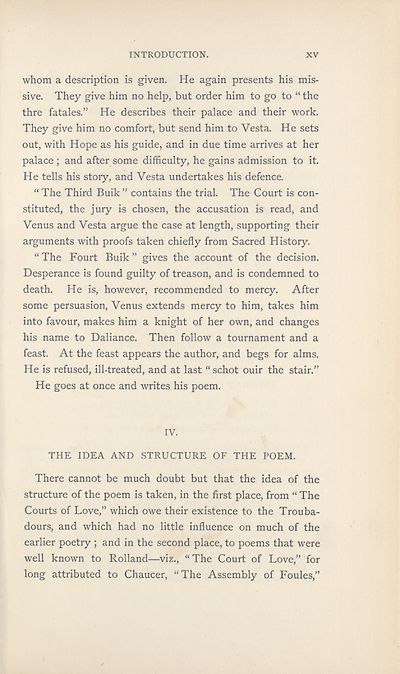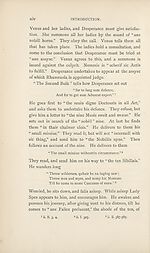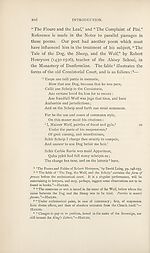Download files
Complete book:
Individual page:
Thumbnail gallery: Grid view | List view

INTRODUCTION.
xv
whom a description is given. He again presents his mis¬
sive. They give him no help, but order him to go to “ the
thre fatales.” He describes their palace and their work.
They give him no comfort, but send him to Vesta. He sets
out, with Hope as his guide, and in due time arrives at her
palace ; and after some difficulty, he gains admission to it.
He tells his story, and Vesta undertakes his defence.
“ The Third Buik ” contains the trial. The Court is con¬
stituted, the jury is chosen, the accusation is read, and
Venus and Vesta argue the case at length, supporting their
arguments with proofs taken chiefly from Sacred History.
“ The Fourt Buik ” gives the account of the decision.
Desperance is found guilty of treason, and is condemned to
death. He is, however, recommended to mercy. After
some persuasion, Venus extends mercy to him, takes him
into favour, makes him a knight of her own, and changes
his name to Daliance. Then follow a tournament and a
feast. At the feast appears the author, and begs for alms.
He is refused, ill-treated, and at last “schot ouir the stair.”
He goes at once and writes his poem.
IV.
THE IDEA AND STRUCTURE OF THE POEM.
There cannot be much doubt but that the idea of the
structure of the poem is taken, in the first place, from “ The
Courts of Love,” which owe their existence to the Trouba¬
dours, and which had no little influence on much of the
earlier poetry ; and in the second place, to poems that were
well known to Rolland—viz., “ The Court of Love,” for
long attributed to Chaucer, “ The Assembly of Foules,”
xv
whom a description is given. He again presents his mis¬
sive. They give him no help, but order him to go to “ the
thre fatales.” He describes their palace and their work.
They give him no comfort, but send him to Vesta. He sets
out, with Hope as his guide, and in due time arrives at her
palace ; and after some difficulty, he gains admission to it.
He tells his story, and Vesta undertakes his defence.
“ The Third Buik ” contains the trial. The Court is con¬
stituted, the jury is chosen, the accusation is read, and
Venus and Vesta argue the case at length, supporting their
arguments with proofs taken chiefly from Sacred History.
“ The Fourt Buik ” gives the account of the decision.
Desperance is found guilty of treason, and is condemned to
death. He is, however, recommended to mercy. After
some persuasion, Venus extends mercy to him, takes him
into favour, makes him a knight of her own, and changes
his name to Daliance. Then follow a tournament and a
feast. At the feast appears the author, and begs for alms.
He is refused, ill-treated, and at last “schot ouir the stair.”
He goes at once and writes his poem.
IV.
THE IDEA AND STRUCTURE OF THE POEM.
There cannot be much doubt but that the idea of the
structure of the poem is taken, in the first place, from “ The
Courts of Love,” which owe their existence to the Trouba¬
dours, and which had no little influence on much of the
earlier poetry ; and in the second place, to poems that were
well known to Rolland—viz., “ The Court of Love,” for
long attributed to Chaucer, “ The Assembly of Foules,”
Set display mode to: Large image | Zoom image | Transcription
Images and transcriptions on this page, including medium image downloads, may be used under the Creative Commons Attribution 4.0 International Licence unless otherwise stated. ![]()
| Publications by Scottish clubs > Scottish Text Society publications > Old series > Treatise callit The court of Venus > (21) Page xv |
|---|
| Permanent URL | https://digital.nls.uk/106994863 |
|---|
| Description | A collection of over 100 Scottish texts dating from around 1400 to 1700. Most titles are in Scots, and include editions of poetry, drama, and prose by major Scottish writers such as John Barbour, William Dunbar, Gavin Douglas, and George Buchanan. Edited by a key scholarly publisher of Scotland's literary history, and published from the late 19th century onwards by the Scottish Text Society. Available here are STS series 1-3. |
|---|

